What does It Take to Be a Triathlete? Behind the Scenes with an Ex-Pro Rinalds Sluckis

In 2008, Rinalds Sluckis, a business digitization professional, had built his own startup from scratch, was working 24/7 and was on the verge of complete burn-out. During a vacation in Portugal, he noticed a billboard advertising a triathlon race and said to his girlfriend Kristine: “I'm going to get into this sport when we return home.”
Rinalds kept his word, and now, 10 years later, he is one of the top triathletes in Latvia, holding several national records, with 7 Ironman and more than 25 half-Ironman races under his belt.
We met with Rinalds for a chat to talk about how triathlon has transformed his life, why bike care and nutrition are important, and what keeps him going despite the various challenges this demanding sport brings to one's plate.
Starting on the Right Track
Rinalds started his own consulting firm back in 2004, and even though the business was doing well, he himself wasn't. After four years of running the company, Rinalds felt overworked and unfulfilled, and was eagerly looking for a change of pace. During a business meeting, Rinalds discovered that one of his clients had changed his routine completely and was now finishing work at 5 pm sharp to do triathlon training.
“I had heard about triathlons before, but at the time, the distances - 3.8 km of swimming, 180 km of cycling, 42 km of running - seemed somewhat inhuman to me,” explains Rinalds.
Soon after that came the significant trip to Portugal, and the rest is history. The sport that seemed impossible to conquer has over the years become an integral part of Rinalds' life.
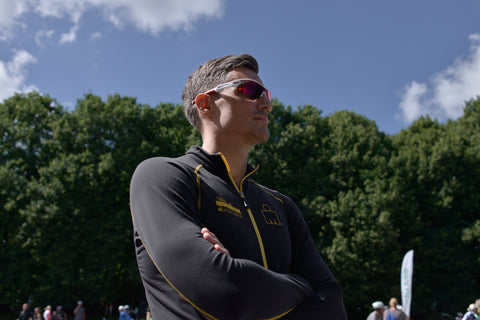
“I started training as a part of a team, but overtime I've changed the structure of my workouts and most often I'm alone rather than together with someone,” says Rinalds. “My coach Romans Melderis can be considered my team. I've been training with him since the very beginning in 2008, and he's definitely helped me acquire my top shape.”
For beginner triathletes who are just starting out, Rinalds recommends joining a local triathlon community. There's also plenty of tri-knowledge and helpful apps on the internet. For example:
- Tri-mag.de. A German magazine and online platform, including the latest news, interviews and podcasts offering the best behind-the-scenes of the triathlon world.
- Slowtwich.com. Online triathlon magazine with product reviews, a bike fit guide, training tips, and several regular columnists, including editor Dan Empfield, the designer of the original triathlon wetsuit.
- Trainingpeaks. A training platform that helps triathletes, cyclists and runners achieve their goals. The platform is used by both athletes and coaches.
- MyFitnessPal. A platform that tracks diet and exercise to determine optimal caloric intake and nutrients for the users' goals.
A Triathlete's Schedule
For two years, Rinalds had the opportunity to train professionally with a pro license which meant - spending 30-40 hours a week on triathlon training, making the sport his main occupation. At that time, Rinalds was working with sponsors, as well as investing his own resources and prize money in the training.
Currently, Rinalds trains for 15-20 hours a week and combines it with a full-time job. “I've become so used to working out that after missing even just a day or two of physical activity, my body demands movement. Even a short swim or 30 minutes of running will do,” he explains.
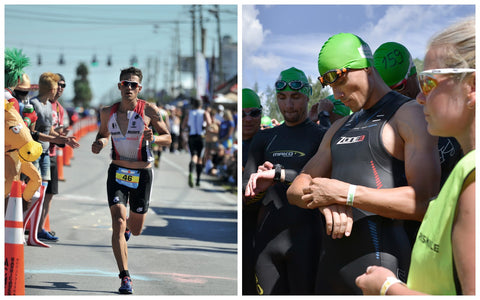
The average day for Rinalds includes two sets of workouts and looks like this:
- 5:30 - wake up
- ~7:00 - arrive at the gym for a 1h+ swimming practice + 1h of running or weight lifting
- 9:30 - arrive at the office
- 15:00-16:00 - leave office
- 16:00-18:00 - afternoon workout
- After dinner - 2h of work
As to Rinalds' yearly schedule, October and November are usually the months of rest with some light working out after the previous Ironman season has ended. The base training with higher training volume, bet less intensity happens during the winter months. This means - spending a lot of time at the gym and improving his swimming technique. “Swimming has always been the biggest challenge for me,” says Rinalds and notes that from a biomechanical point of view, swimming is the hardest discipline of the three.
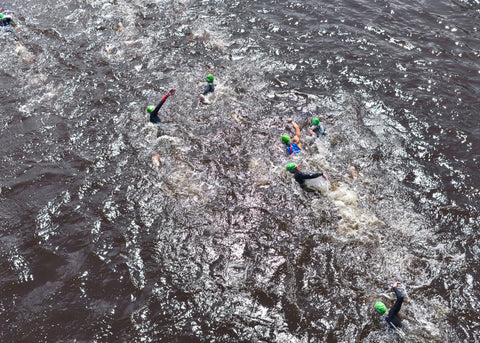
However, if you work on it a lot, great results can be achieved. “Aleksandrs Prokopcuks, Latvian long-distance runner and coach, once said to me that with plenty of effort, you can even teach a bear to run. In the end, it all comes down to how much time and resources you're willing to invest,” Rinalds concludes.
The Beauty of Cycling & Bike Must-Haves
There's no triathlon without cycling, which means - the bike must be just as ready for the race as the person who mounts it.
“If there is even the slightest technical issue, you're done. That happened to me in Sweden once - the tire ruptured twice. After that, there's just no point to continue,” says Rinalds.
“Your ride is such an important part of the whole race. When I leave my bike in the transition area the day before, I even chat with it for a little while. Dead serious!”
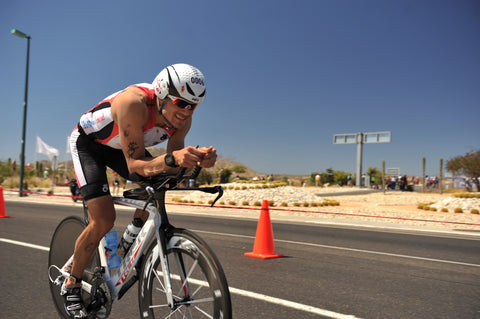
Rinalds believes that the transition area [a place where the athletes change gear for different segments of the race - aut.] can reveal how much the triathletes have invested in not only their bikes, but in their training, too.
“Some athletes have taken care of everything - their shoes match their helmet, their gear is on point. Their bike is spotless, and you just know they have the same serious attitude towards the sport itself. Others arrive with a rusty chain, and they don't care. In my opinion, it just comes to reflect your professional hygiene.”
“I think that in a triathlon, some part of you wants to show the bike off. But you also want to see how others have upgraded their rides. It's impressive to see how dedicated triathletes invest in their gear, it's quite remarkable. Every transitional area reveals that both triathlon and cycling are such aesthetically beautiful sports.”
Asked about his own bike must-haves, Rinalds emphasizes that there are three main components he cannot do without:
Eating Your Way to a Healthy Body
Triathlon is definitely the sport where food is fuel. In Rinalds' case, triathlon was the catalyst of changing his own eating habits, and those of his family, too.
“I've often talked with Kristine, who's now my wife, that if it weren't for triathlon, we don't know what we would be eating, what our lives would be like. At the moment, the food that we put into our bodies helps us feel great and stay in good shape for our age - which is almost 38 years of age.”
Rinalds emphasizes that at first it might be confusing to find your bearings in the world of nutrition. Rinalds read a lot of books, consulted with nutritionists, but in the end it all comes down to these basic principles:
- Fuel your body. If you're training intensely or preparing for a race, you need loads of energy for your body to keep going. Fill up on high-quality carbohydrates - rice, vegetables, fruit.
- Eat for recovery. Healthy fats and protein are needed for growth, muscle maintenance and immunity. Include fish, nuts, avocado in your diet.
- Don't skip meals. By skipping a meal, you risk nutrient deficiencies, fatigue, poor mental function, muscle loss and other health concerns.
As to food myths and quirky tricks like eating rice with condensed milk, Rinalds laughs and says he's heard some too: “Like devouring a pot full of pasta the day before the race or single-handedly vanquishing a whole cake.”
“But there's no need to be excessive. In short, an athlete's diet is basically a healthy diet. Make sure it's well-balanced and you're getting enough micro and macro nutrients, then you'll be good to go,” he summarizes.
More than just a Physical Race
But what does a triathlon feel like - and what goes through a triathlete's mind when aiming for that finish line?
Rinalds explains that the day of the race is like the culmination of a very long journey. “A couple of days before a triathlon, you're in constant emotional upsurge, feeling very confident. But at the same time - you're also nervous about things beyond your control, like bike trouble or other technical issues that no one can predict.”
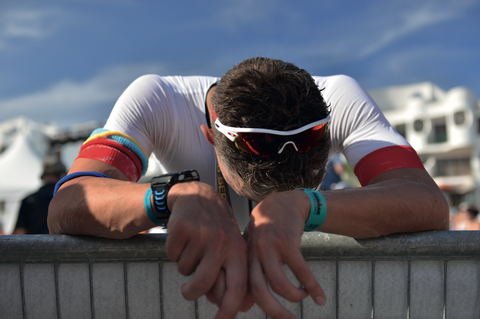
There are several typical stages Rinalds goes through during a full Ironman:
- Stage 1. You're on the shore of the ocean, on the starting line with 2000-2500 other people. Everyone's got their own agenda on their mind - be it getting a slot at the IRONMAN World Championship in Hawaii or just finishing the race. The excitement is mounting.
- Stage 2. You're in open water. Swimming is the most daunting discipline of the whole race, but under no circumstances can you succumb to discomfort and stress. Hundreds of other athletes surround you, arms swinging, legs paddling, trying to avoid getting kicked in the face. You're trying to find a free spot of water or a group of people who swim in a similar speed. There, found it! Now, keep going.
- Stage 3. You've reached the shore and you're out of the water. If you've had no problems so far, you're off to a good start. Jump on the bike and start cycling.
- Stage 4. 180 km done, switching to running. Feeling slightly tired, to say the least.
- Stage 5. The last two hours - or final 15-20 km. You're constantly fighting through different sorts of excruciating pain and cramps and talking to yourself. Every step is a never-ending discussion arguing both sides on the case of “Why are you doing this - just quit!” vs. “You must keep going!”.
- Stage 6. The peak of the race some 500 meters before the finish. You're feeling a mix of positive emotions and reach a state of utter euphoria upon crossing the finish line.
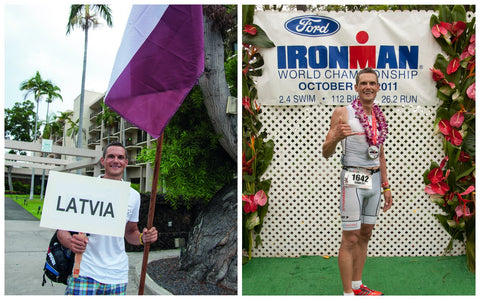
“The sense of accomplishment and relief after conquering the race is extraordinary,” says Rinalds. “It's something that can be felt only after 8-9 hours of completely submitting yourself to a full day of strenuous work and stress.”
Rinalds emphasizes that focusing on your breathing is a must if you want to get through the pain: “As humans, we are never more aware of our bodies than when we hear our own breathing.”
But there's one other important aspect that keeps Rinalds going. “My family is a very big piece in the picture, they motivate me so much. Knowing that you'll see them cheering you on somewhere along the race brings you closer to the finish line one step at a time.”
The Best Battle to Win
A triathlon is such a demanding race that it can leave one wondering - why in the world do people keep doing this to themselves?
“I do believe that you must enjoy pain or have some degree of masochism to be a triathlete,” says Rinalds jokingly. “But to be honest, there's no single answer. For me, it's the process, the training, the lifestyle, the structure to your daily rhythm. It's everything.”
“Triathlon means overcoming yourself and fighting your inner demons. And that's the best battle to win.”
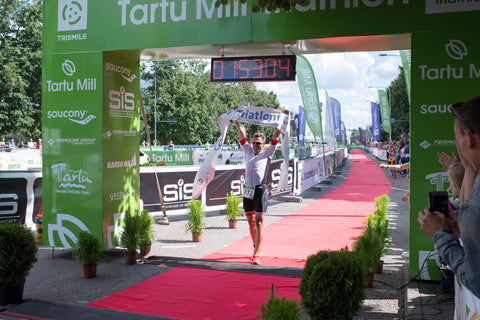

















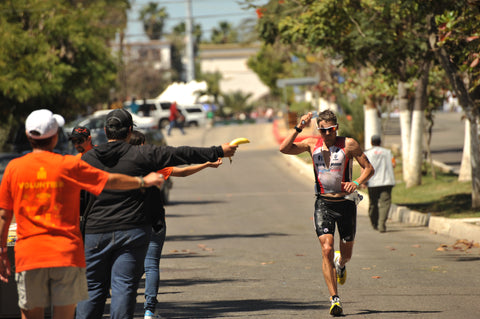











If you get to see a good post, then the whole day is very happy that means it goes better and I am experiencing very positive seeing your post, I have seen such posts very rarely and I hope you like it too. K will keep writing in his life.
Leave a comment